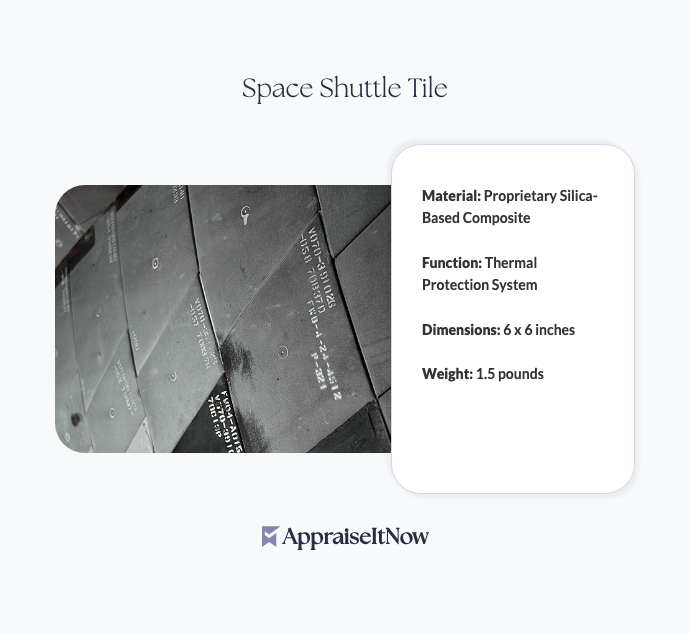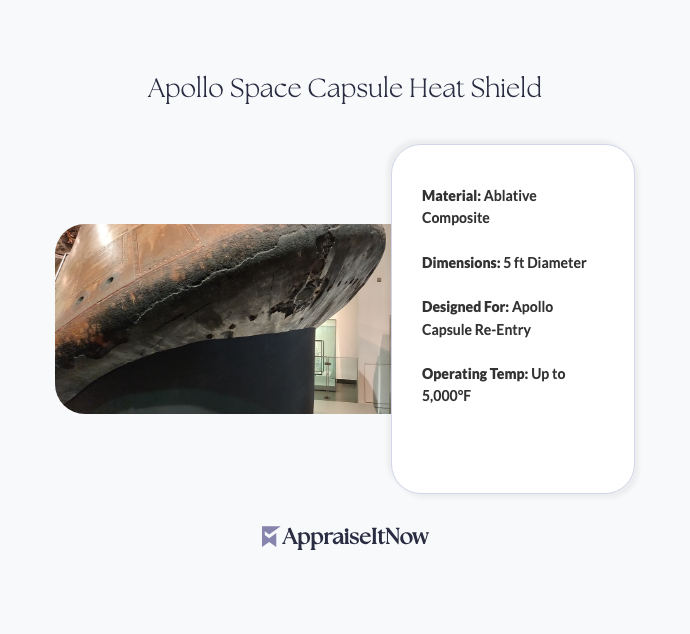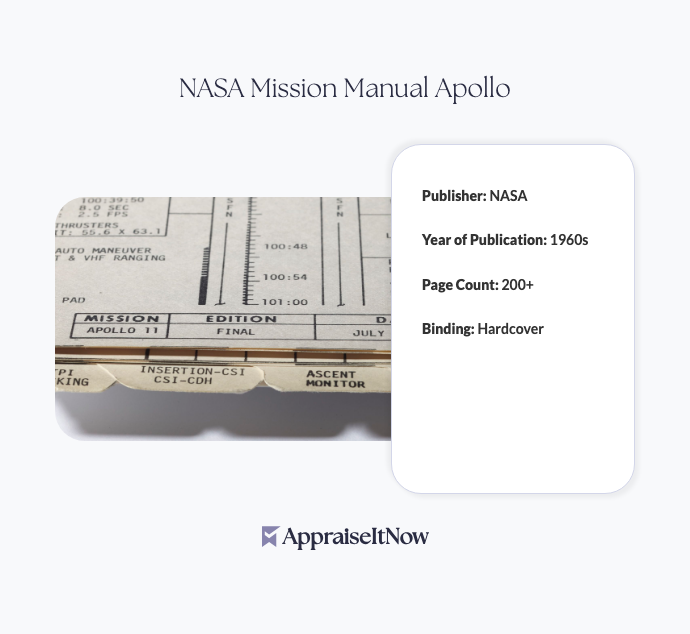<h1>How to Get Your Space Shuttle Tile Appraised</h1>
<p>Space Shuttle tiles represent one of the most extraordinary technological achievements in modern history—and they're becoming increasingly valuable collectibles. If you own or are considering acquiring a genuine Space Shuttle tile, understanding how to properly appraise this specialized item ensures you have accurate documentation for insurance, sale, or collection purposes. These silica-based thermal protection components, valued between <strong>$9,000 and $15,000</strong>, require expertise from appraisers familiar with both aerospace engineering and historical collectibles.</p>
<h2>Understanding Space Shuttle Tile Specifications and Value Drivers</h2>
<p>Your Space Shuttle tile's worth stems from its unique engineering heritage and the extreme conditions it was designed to withstand. These tiles were crafted from a proprietary silica-based material, representing cutting-edge material science from NASA's Space Shuttle program. Each tile was individually engineered and handcrafted to provide maximum thermal protection during the punishing environment of space launch and re-entry—temperatures that reached up to <strong>2,300°F</strong> while maintaining structural integrity.</p>
<p>The sheer complexity of manufacturing these tiles contributed directly to their collectibility. Over <strong>24,000 tiles</strong> covered each Space Shuttle, yet their intricate production process and limited output make individual tiles sought-after pieces for collectors and aerospace enthusiasts. First deployed on Space Shuttle Columbia in 1981, these tiles represent a specific era of human space exploration that has since transitioned to newer technologies. This historical milestone significantly impacts how appraisers evaluate your tile's market position.</p>
<div class="callout tip"><p><strong>Appraiser Focus</strong></p>
<p>Appraisers specializing in aerospace memorabilia examine whether your tile comes with documentation of its specific Shuttle mission or location on the vehicle, which can affect value by 15-20%.</p></div>
<h2>Identifying What Makes Your Space Shuttle Tile Authentic</h2>
<p>Before seeking appraisal, you'll want to understand what distinguishes genuine NASA tiles from replicas. Authentic Space Shuttle tiles display specific characteristics that professional appraisers look for when determining whether your item qualifies for <a href="/types/memorabilia-and-collectibles">memorabilia and collectibles</a> valuation at the higher end of the market range.</p>
<p>Genuine tiles feature distinctive thermal degradation patterns from their service history, visible serial numbers or identification markings from NASA quality control processes, and the characteristic silica material composition that creates their unique appearance. The tile's thickness, typically around two to four inches, and its lightweight yet brittle composition reflect the specific engineering requirements NASA established. Documentation proving your tile's provenance—whether it comes from surplus NASA inventory, legitimate auctions, or authenticated space program collections—becomes critical during appraisal.</p>
<p>The question of how Space Shuttle tiles were attached to the vehicle's structure matters to appraisers because it affects whether your tile retains original attachment hardware or adhesive residue. While most collectible tiles no longer carry this hardware, evidence of proper original installation adds authenticity verification that strengthens appraisal confidence.</p>
<h2>How Appraisers Evaluate Thermal Protection Material</h2>
<p>Professional appraisers approaching your Space Shuttle tile apply specialized knowledge about aerospace thermal protection systems. Understanding what Space Shuttle tiles are actually made of—a low-density, high-temperature silica composite—informs the appraiser's assessment of authenticity and condition. These silica tiles represented a revolutionary advancement in reusable spacecraft design, quite different from earlier single-use heat shields.</p>
<p>When evaluating your tile, appraisers examine factors beyond simple appearance. The tile's density, surface characteristics, and any visible wear patterns tell the story of its operational history. Tiles that flew on actual Space Shuttle missions typically show specific thermal signatures from their position on the vehicle—nose tiles experienced different heat profiles than fuselage tiles, for instance. An appraiser familiar with <a href="/blog/appraising-artifacts-and-antiquities-evaluating-historical-finds">historical preservation and artifact valuation</a> understands these subtle distinctions that separate high-value specimens from lower-grade examples.</p>
<div class="callout note"><p><strong>Condition Grading</strong></p>
<p>Space Shuttle tiles graded as "excellent" (minimal thermal wear, clear markings) typically appraise at $12,000-$15,000, while tiles with moderate cosmetic damage fall into the $9,000-$11,000 range.</p></div>
<h2>Comparing Space Shuttle Tiles to Other Aerospace Collectibles</h2>
<p>Your Space Shuttle tile exists within a broader collector market for aerospace memorabilia and historical artifacts. While questions like "what are spaceship floors made of" address general spacecraft construction, your silica tile represents a specific, highly specialized component. Understanding this distinction helps appraisers position your item correctly within the memorabilia market rather than treating it as generic aerospace scrap.</p>
<p>Unlike more common Space Shuttle artifacts—such as mission patches or debris samples—authentic thermal protection tiles command premium prices due to their engineering significance and limited availability. The tiles' role as <em>crucial for safe re-entry from space</em> gives them narrative weight that transcends typical collectible appeal. This historical importance explains why documented tiles from specific Shuttle missions outpace tiles of uncertain provenance in appraised value.</p>
<h2>Documentation You'll Need for Your Appraisal</h2>
<p>Successful Space Shuttle tile appraisals depend heavily on supporting documentation. If your tile came from a reputable source—whether acquired through NASA surplus auctions, established aerospace museums, or documented space memorabilia dealers—gather all certificates of authenticity, purchase records, and any accompanying literature. This paperwork becomes part of your appraisal file, significantly strengthening the appraiser's confidence in valuation.</p>
<p>Original NASA documentation proving your tile's program association or mission history commands substantial premiums. Even without specific mission documentation, reputable acquisition from recognized aerospace heritage sources provides the provenance verification that appraisers require. Photographs showing the tile's serial numbers, markings, and overall condition should accompany your appraisal request, allowing for preliminary assessment before the appraiser conducts hands-on evaluation.</p>
<p>When seeking <a href="/types/personal-property">personal property appraisals</a>, having detailed photographs from multiple angles and close-ups of any identifying marks or serial numbers helps professional appraisers assess condition and authenticity remotely before scheduling in-person examination.</p>
<div class="callout tip"><p><strong>Documentation Best Practice</strong></p>
<p>Create a detailed inventory of your tile including photographs, measurements, any attached documentation, and the source from which you acquired it—this speeds appraisal timelines significantly.</p></div>
<h2>Condition Assessment and Preservation Impact</h2>
<p>Your Space Shuttle tile's physical condition directly affects its appraised value within the $9,000-$15,000 range. Tiles that have been properly preserved in climate-controlled environments, protected from direct sunlight and humidity fluctuations, typically retain higher value than those stored in garage conditions or exposed to environmental stress. The silica material's brittleness means that tiles with visible cracks, missing corners, or significant thermal damage will appraise considerably lower than structurally intact examples.</p>
<p>Storage and preservation immediately begin affecting value the moment you acquire your tile. Unlike artwork requiring specialized conservation, Space Shuttle tiles need only basic environmental protection—consistent temperature and humidity, dust-free storage, and protection from mechanical stress. Professional appraisers factor preservation quality into their assessments, recognizing that well-maintained examples reflect better market desirability and future resale potential.</p>
<p>The distinction between thermal degradation (cosmetically acceptable and authentic) versus structural damage (reducing functionality and safety profile) matters significantly during appraisal. Your appraiser distinguishes between these conditions when developing valuations suitable for insurance documentation or <a href="/blog/personal-property-appraisals-for-charitable-donations-maximizing-tax-benefits-through-accurate-valuations">charitable donation purposes</a>.</p>
<h2>Working with Specialized Appraisers for Space Program Artifacts</h2>
<p>Finding qualified appraisers for Space Shuttle tiles requires identifying professionals with aerospace memorabilia expertise. While many general appraisers handle collectibles, tiles demand specialized knowledge about NASA material science, Space Shuttle program history, and thermal protection system engineering. <strong>AppraiseItNow</strong> connects you with credentialed appraisers (AAA, ISA, ASA, CAGA, AMEA certified) who possess the technical background necessary for accurate aerospace artifact valuation.</p>
<p>Professional appraisers approach your tile with methodology ensuring USPAP compliance—the Uniform Standards of Professional Appraisal Practice that insurance companies, legal proceedings, and financial institutions recognize. This certification provides confidence that your valuation withstands professional scrutiny and serves legitimate purposes whether for insurance replacement cost documentation or estate planning.</p>
<p>The appraisal process for aerospace artifacts typically involves remote preliminary assessment using photographs and documentation, followed by in-person inspection measuring exact dimensions, examining markings, and assessing structural integrity. This thorough approach ensures the final valuation reflects your tile's true market position rather than relying on generalized estimates.</p>
<h2>Market Demand and Collecting Trends</h2>
<p>Space Shuttle tiles attract collectors driven by diverse motivations—aerospace enthusiasts fascinated by Space Shuttle program history, investors recognizing alternative asset appreciation, and institutions building space exploration collections. The tiles' historical significance—being <em>handcrafted and individually inspected</em> as part of the groundbreaking reusable spacecraft program—generates steady collector interest that supports the $9,000-$15,000 valuation range.</p>
<p>Questions about current tile values often emerge because these artifacts rarely appear in mainstream auctions or retail settings. Professional appraisers monitor market transactions, private sales, and specialized aerospace memorabilia dealer activity to understand real-time market conditions. Your tile's value reflects not just its technical specifications but the passionate community of collectors willing to pay premium prices for genuine space program artifacts.</p>
<p>When <a href="/blog/appraising-artifacts-and-antiquities-evaluating-historical-finds">appraising artifacts and antiquities</a>, appraisers recognize that space-related memorabilia has demonstrated consistent appreciation. The combination of limited supply (no new tiles will ever be manufactured), historical significance (representing a specific era of human achievement), and educational value supports the collectible market for authentic Space Shuttle thermal protection tiles.</p>
<div class="callout note"><p><strong>Key Takeaway</strong></p>
<p>A certified professional appraisal of your Space Shuttle tile provides authoritative documentation of its authenticity, condition, and fair market value—essential whether you're insuring this remarkable artifact, preparing it for sale, or establishing its worth for estate and financial planning purposes.</p></div>







.avif)







